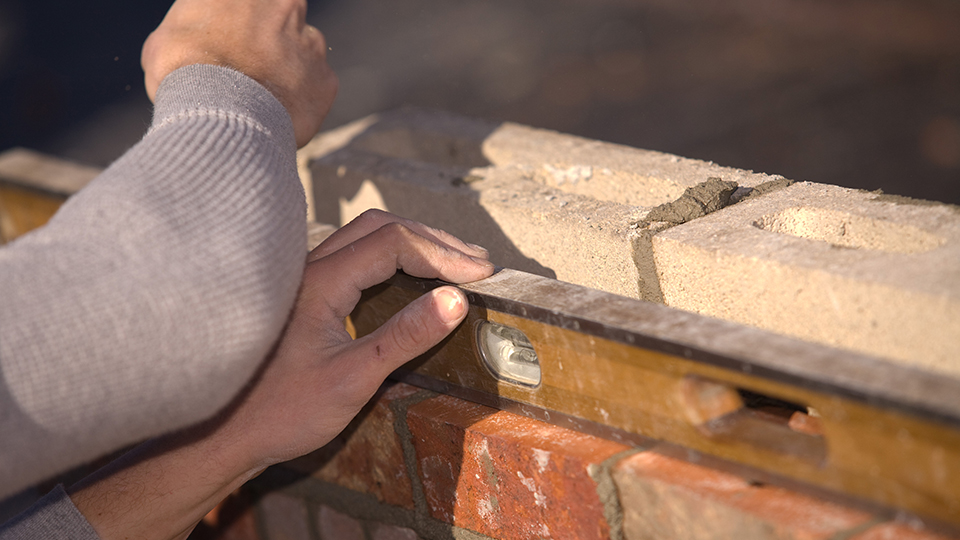Masonry Recruiting and Training
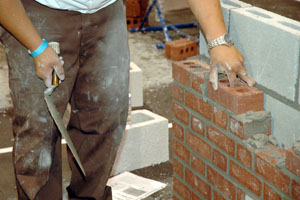
No matter what part of the country we travel to, the overwhelming concern of every mason contractor we meet is where can we find enough quality masons to do all of the work? Nationwide, contractors are looking for masons that are well skilled with the dedication to the trade that the older masons exhibited. Of course, they also want to know who can solve the problem.
We believe each mason contractor must challenge themselves to solve manpower problems. When was the last time you went to a local high school to talk to students about careers in masonry? When was the last time you helped train an apprentice? When was the last time you visited a local training program?
As a mason contractor, you are the key to the puzzle. You will find in this section an outline for your participation. The first step is done ... you have clicked on our website. Now the toughest and most rewarding part begins ... recruiting and training, the solutions to the manpower puzzle.
We applaud your involvement. If there is anything we can do to be of assistance, feel free to call us at the MCAA National Office. We welcome your questions or ideas.
Good luck!
Overview
Most areas of the United States are experiencing a shortage of manpower with regard to the construction industry in general. The masonry industry is no exception. The following are just some of the many reasons for this shortage:
- Experienced masons retiring
- More attractive careers promoted in the technology arena
- Over reliance on throwing good money after bad in an attempt to solve the industry's manpower problems
But perhaps the greatest factor is an attitude that someone else should solve the problem.
Currently, contractors are in desperate need of new masons. The demand for skilled masons far exceeds the supply to fill that demand. The industry is retiring more masons than training new ones to replace them. If future needs are factored in, the need for more skilled masons is compounded.
The one common denominator missing from most programs and the one critical component missing from a successful recruitment and training program is the aggressive involvement and commitment by mason contractors.
Contractor Involvement and Commitment
What exactly is meant by contractor involvement and commitment? Too often, mason contractors complain about the amount of skilled workers available to hire, the quality of their skills and the bricklayer's dedication to the trade.
But when faced with solutions to their shortfall in the labor force, contractors have always looked to someone else to solve the problem. By the union doing such a good job decades ago at recruiting and training, we have developed a "welfare state" in the masonry industry ... the attitude that I don't have to recruit, someone else will take care of it ... it's not my job!
Commitment and involvement means total dedication and commitment of time, energy and resources on the part of all mason contractors in the region (both union & non-union) to recruit and train the industry's workforce. This commitment and involvement is the only solution to our long-term manpower needs.
Contractors must become involved in:
- Committing 2-4 hours per week to recruitment and training activities
- Serving on an apprenticeship committee which oversees the program
- The decision processes of reviewing and selecting a curriculum and training books
- Determine class location
- Establishment of tuition
- Hiring and reviewing the class instructors
- Periodically attending apprenticeship classes
- Hiring only quality apprentices
- Attending career days quarterly
- Establishing preapprentice programs in local high schools
The Recruitment Program
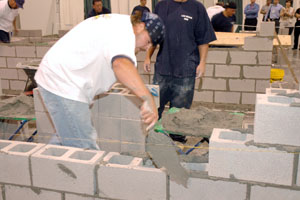
Before you can train quality masons, you have to find young people interested in becoming quality masons, which is the most difficult task facing the industry for many contractors. It is difficult to find new young quality masons because our school systems work against us. Local high schools are evaluated by how many of their school's students go on to earn a college degree. Guidance counselors work against us because when they are faced with a student that seeks a career in construction, they guide the student to non-masonry trades such as electrical and mechanical construction trades. Masonry is never mentioned. Even society in general since the late 1950's and 60's steered future generations away from the trades. American families often threaten school-aged children to study hard and do their homework or end up being a construction worker for the rest of their lives.
Even the image of the masonry industry has worked against us. The masonry industry's image of dirty hard work in harsh weather conditions makes it difficult to appeal to young workers who are often computer and high-tech oriented.
Building a well skilled, ample workforce will not happen overnight. It will take years of image building, education and effort to attract the workforce the industry needs, and it's the mason contractors who must commit themselves to recruiting. Commitment to conduct at least one career day by every contractor every school semester. Recruitment is not difficult, a little intimidating, but often rewarding.
How Do You Begin?
- Form recruitment teams made up of a mason contractor(s), industry supplier(s) and several apprentices currently in the trade. The apprentices should be prepared - well dressed, well educated, capable speakers ... good looking won't hurt. Students will relate better to young apprentices.
- As a recruitment team, get together and prepare your career day. What will you say? Don't write a speech. Do a detailed outline as to what will be covered and then practice your presentation in front of a video camera several times. Don't let one person do the talking. Use videos and hands-on demonstrations. Bring in brick, mortar and trowels and let the students lay brick while you talk to them about the trade. Make it fun. A suggestion is to reserve the last ten minutes for a mini-fastest trowel competition. Ask the principal of the school to compete with one student from the class in a mock competition as to who can lay the most brick the best. Give out a prize. Students like prizes such as duffel bags, backpacks or gift certificates to a local movie theater. Oh, and make sure the student wins!
- Develop a "mentoring" network with your good journeymen who are willing to talk to students. If students need further information about careers in masonry, they may be intimidated talking to you (the mason contractor), but they may feel comfortable talking to a young journeyman.
- Identify the schools in which you want to conduct a career day. Call the schools to identify the names of guidance counselors and more importantly "shop" teachers.
- Contact the teachers and inquire about conducting a career day. If they are willing, schedule a career day and let them know about any unique ideas you may want to do for the career day such as a bricklaying contest with the principal.
- Promote the career day in the school (use the MCAA Check Out a Career in Masonry poster). You should begin promoting it several weeks before the actual career presentation. Make sure that a video player and monitor are available for your presentation.
- Have a small gift/bag for each student. Often brick manufacturers/glass brick manufacturers will produce brick or glass block banks with a logo or name on it (the school logo is best). Ask your supplier to donate the giveaways.
- Conduct your career day. Have fun.
- After the career day, offer to set up a field trip to a job site. Have the mentor journeyman take the students around the job site.
- If there is interest by the teachers and school, offer to run a masonry class at the school. This would serve as a preapprenticeship program and prescreen new masons. Work-toschool programs such as a high school masonry curriculum can also be useful in promotional efforts. If the high school masonry class works on a community project, most local news outlets would cover the activity.
- If you have a willingness to start a high school masonry class, the mason contractor (and apprenticeship committee) should provide all materials, books and the instructor to run the program. A committed school is invaluable in assisting the industry's search for skilled, competent workers.
- Often times, individual schools and school districts will run an annual career fair where industries and companies are given a booth (similar to a trade show) and students visit from booth to booth. If you are participating in this type of career program, make your booth appealing to visit. Hands-on demonstrations work best in this format. Giveaways are useful in a career fair format as well.
- Don't limit your career days to high schools. Middle schools (seventh and eighth grade level students) often take classes to various local business and governmental operations to expose young people to "real life" activities/careers. Taking students on a field trip to a nearby masonry project would often be welcomed. Give the students a hard hat (to keep) and let them lay some brick. (What kid doesn't like to play in the mud and get dirty?) If the project is a local school, invite the school board members and local press along on the field trip. It would be a great promotional event.
- Active laborers are a great source for future bricklayers. They understand the hardships of the trade and they generally have a basic understanding and a skill level the average young apprentice doesn't have. Unfortunately, many contractors want to pay the laborer the beginning mason apprentice wage. With many laborers making nearly what a mason makes, many laborers (especially those with families) find it difficult to drastically cut their wages while they are formally learning the craft. We strongly urge that you resist the temptation to radically cut the laborers wage during training. If you still want to cut the laborer's wages, consider granting credit to the laborer for time worked in the trade so their speed through the training program is fast. Remember that laborers understand the trade. They have made masonry a career and are less likely to quit like the average new apprentice.
Career Fairs
Career fairs are an excellent way to spread the word about occupations in masonry quickly to many people. With little effort on your part, career fairs can greatly enhance your recruitment endeavors. Typically, large numbers of people file through a showroom floor gathering information from many sources of vocational fields. The longer you can keep their interest in your booth, the better the outcome will be for your recruitment campaign.
Plan on at least two people in the booth at all times. This will not only assist in set-up, takedown, and crowd control, but will provide the opportunity for breaks. A hands-on demonstration always creates instant interest. Demonstrations usually draw the biggest crowds, but giving the attendees a chance to "try their hand" at laying brick and block is an excellent opportunity to establish a rapport, answer questions, and will give topics for discussion on a follow up call.
Often career fairs are free, however, if a fee is charged, think about combining efforts with area suppliers. Think about contacting suppliers for give aways. Many times suppliers are eager to donate glass block banks, pens, stickers and company paraphernalia for little or no cost.
With a little time, effort and money on your part, career fairs are a fast, easy way to help promote masonry careers.
Comprehensive Training Program
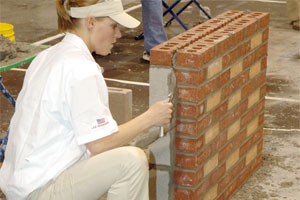
Now that your recruitment program is underway, a comprehensive, quality training program is needed. The MCAA National Office urges that a three year, Bureau of Apprenticeship Training (BAT) approved curriculum be taught. Resist the temptation to take short cuts in your training just to get the apprentices on the wall and producing. Our industry is in danger of losing the total craft and art of masonry. As older masons and instructors retire, we can't retire the art with them. Make the training program and career opportunity worthwhile to the new mason apprentice. If the experience the apprentice receives is positive, they may promote careers in masonry to their friends and family. If we treat the apprentice as less than a valued resource to the masonry industry, they would be less likely to promote the trade and may even quit themselves.
How to start a quality training program:
- Form an apprentice committee with the responsibility of recruitment and training. The committee should be made up of mason contractors, some suppliers, local union officials if applicable, and a student (apprentice) representative elected by the apprentice class.
- Establish directives that the committee will follow. Directives are the guidelines that everyone will abide by (similar to by-laws). Some examples of directives are as follows:
- Contractors are prohibited from hiring a fellow contractor's apprentice without the express consent of the apprentice's employer. If a contractor hires another contractor's apprentice without consent, the hiring contractor will reimburse the current employer for all the apprentice's school tuition and expenses. Failure could result in a ban from class training (or possibly indenturing is an option).
- Tuition will be prepaid by the student and reimbursed after each semester based on the student's grade. For example, an "A" is 100 percent reimbursed, "B" is 80 percent and "C" is 60 percent.
- Contractors will also pay students to attend the classes. Pay will be in the form of a bonus based on class grade at the end of each semester.
- Apprentices that have preapprentice experience can receive credit for their current ability.
- Contractors are prohibited from hiring a fellow contractor's apprentice without the express consent of the apprentice's employer. If a contractor hires another contractor's apprentice without consent, the hiring contractor will reimburse the current employer for all the apprentice's school tuition and expenses. Failure could result in a ban from class training (or possibly indenturing is an option).
- Establish a curriculum and course books to be used. (The MCAA has a three-year curriculum that has been reviewed and approved by the BAT. In addition, our curriculum can be tailored to your needs and has received high marks.) File with the U.S. Department of Labor, Bureau of Apprenticeship Training.
- Determine your classroom location. Community colleges or high schools will often lease space for your program. They may also offer support in selecting an instructor. Industry suppliers such as block manufacturers or brick distributors often will give you space at no cost.
- Hire a quality, motivated, skilled instructor. This is the key to your program. The right instructor, who is knowledgeable and can relate to the students, will make your program succeed. The wrong instructor will kill the program.
- Determine the program budget and establish the class tuition. When you determine the budget, budget a surplus (reserve) so that in future years, if enrollment drops, the training program can still afford to function. In addition, your tuition should be high enough in the first year program to subsidize the smaller third year classes.
- Recognize levels of achievement by giving certificates after each year of completed class and on-the-job instruction. Establish an annual apprentice awards dinner to recognize the apprentices' achievement. Consider running a congratulatory advertisement with the names and photos of each apprentice in the local newspaper. (This ad will also be a great subtle promotional ad for recruitment and even masonry promotion.)
- On-the-job training is by far the most critical facet of mason training and often the most overlooked. Finding the right journeyman to work with the apprentice is crucial. The right journeyman will instill the proper skill level, dedication and work ethic to the apprentice. Unfortunately, many journeymen don't want to be bothered with an apprentice. They don't feel that it's an honor to train the apprentice. Mentoring should be recognized by each contractor and even the local association.
- Award a bonus to each foreman or journeyman that trains an apprentice. Give the bonus at the end of each year (or semester). Possibly base the size of the bonus on the apprentice's grade.
- Give incentives to the foreman or journeyman for the apprentices based on:
- Attendance at class
- Being on time at the job every day during the semester
- Zero accidents
- Zero mistakes on the job
- There's no limit to your creativity
- Give special recognition or awards to the journeyman/mentor at the annual awards dinner. (Don't forget to invite the journeyman's spouses.)
- Don't let just any journeyman become a trainer/mentor. Make your journeyman achieve a minimum standard of craftsmanship and commitment before they are qualified.
- Make the journeyman attend classes (such as motivational and other management classes/seminars) to achieve and maintain the mentor/trainer status. An hour block of time immediately after work is ideal.
- Members of the apprentice committee should make periodic visits to the training classes to ensure quality training. It will also express the committee's commitment to the program, the students and the instructors.
- Ask local suppliers and manufacturers to contribute materials and equipment to the program. Most are eager to contribute. If you get great participation and you end up with too many contributing suppliers, rotate the suppliers so you are able to use all of them throughout the year.
- Administrative support is important. Records must be kept. If you can't afford a fulltime administrator, hire a part-time person or reimburse a member of the apprentice committee to perform this function. (Don't forget to add this to your budget.)
- Now that your mason apprenticeship program is up and running, start a laborer's training program (shorter than the mason program, but important just the same).
Beyond Recruitment and Training
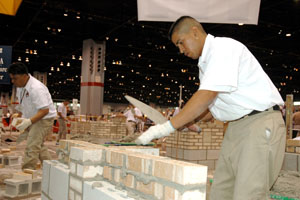
Now that your recruitment and training programs are up and running, you need to start thinking about what can be done to decrease the turnover rate of employees and retain those that you have recruited and trained. If you find that your organization is experiencing significant turnover, you need to do an in-depth study of the reason. First, if the individual in your organization responsible for hiring has been doing this for more than five years, chances are they are burned out and no longer capable of making good decisions. Put someone else or a couple of people in their place to hire new employees.
Don't be surprised if during your examination of your retention problem, you find one or more foremen's names coming up repeatedly. Every company is going to have supervisory people with poor people skills, but who possess exceptional production or customer liaison skills. Identify this individual and at all costs, do not put a new employee in their supervision. Under no circumstances should a new employee be placed with a supervisor as a test of what they can or can not handle. Give new employees a chance to share in the success you enjoy by placing them with a supervisor skilled at motivating the new hire.
Rewrite, edit or do whatever is necessary to put the company policy handbook in understandable language and adhere to it. Hold your employees accountable at all costs. No exceptions. Include in this policy manual that exit interviews will be conducted when final paychecks are issued. A discerning listener will be able to identify why some of the employees are leaving. This will help you identify the problem. If you can identify the problem, you can solve it.
Make maps of how to get to each of your job sites from your office location. On these maps, list the foreman's name and job site phone number. Make sure the new employee has your phone number as well. In addition, make sure your new employees have the following information:
- Company weather policy - when you work and when you don't
- Name of person to call in case of illness or car trouble
- Company policy regarding beepers and cell phones
- A name and contact number for the employee in case of emergency
- Company attendance policy and consequences for absences
- Name of person who handles W4 tax information
- Name of person to contact if you are not available
Meet with your key people and create a job profile of the skills your company needs in an entrylevel position. It's helpful to begin with a job description of what will be expected of the new employee. Divide this list into hard skills (forklift operation, scaffold erection, saw work, etc.) and soft skills (able to work with people, able to work alone, etc.) and weigh each of these skills in order of priority for you. Create a checklist of this job profile and the next time a candidate walks into your office for an interview, have this sheet before you or fill one out immediately after the interview is completed. If the candidate does not meet your criteria, thank them for their time and send them to your competitor who is ready to spend a lot of money recruiting more people in his company.
It is our job to make people want to work with our company.











